Structures plan production example
Last updated: 2024-05-03
 Overview
Overview
This example will cover the basic steps needed to complete structures plans sheets listed below.
Exercise files: pln-prod-struct-xmpl.zip
Getting started
-
Open Civil 3D using the Civil 3D 20XX WisDOT-BOS desktop shortcut. This will open Civil 3D with the Structures profile , which is required for drafting structures plans. If the shortcut is missing from your desktop, follow the instructions on the Structures profile page.

- Before starting structures plans, make sure you have collected all necessary reference files, and that you have a layout file created according to the Structures layout file page.
 Structures sheet set
Structures sheet set
Follow the instructions on the Structures sheet sets page to create a new sheet set. An example sheet set is provided with the example files: SheetSet.dst.
 General plans sheet
General plans sheet
File setup
- Start a new drawing file with the Structures drawing templates .
- Save the new file to the structure CAD folder. The drawing should be named YEAR-01-STRUCTID_GP.dwg, or for this example 2021-01-B05486_GP.dwg
-
Attach all needed references. For more information, see Structures external references. After referencing the example reference files, the drawing should look like this:

-
Rotate the view so the structure alignment is horizontal and set up a UCS for the structure by following the steps on the Structures coordinate systems page. The drawing should now look like this:

Info: Culverts, retaining walls, and other ancillary structures tend to be aligned along the structure, not the roadway.
Structure plan setup
- Reference in the Structures layout file , or manually draw the outline of the structure plan. Be sure to use appropriate Structures template layers.
- Draw a boundary around the structure plan and use that boundary to clip all references Structures external references.
- Determine the best annotation scale for the structure plan by inserting a Viewport Outline block (Structures tool palette > Misc. palette > Viewport section > Outline) with a scale of 1/12. SCALE the outline as needed to fit the plan in the upper left corner of the outline. The scale needed for the outline will be equal to your annotation scale for the plan. Set the active annotation scale.
For the example structure, a scale of 12.0 works best. The plan view looks like the image below inside the viewport outline block.

Sheet layout setup
- Create a front sheet layout using the structures sheet templates. For more information see the Structures drawing templates page.
- SAVE the drawing so the new layout can be added to the sheet set.
-
Right-click the new sheet layout and Import Layout as Sheet... to add the sheet to your sheet set.

Requirement: You must have your sheet set open in the sheet set manager (SSM) first.
Info: For more information about how to add sheet layouts to a sheet set, see the Structures sheet sets page.
-
After completing the sheet properties in the sheet set manager, REA to update the sheet border.

-
Open the General plans blocks #gp. With the sheet layout open, place the Design Data, Design Contacts and Sheet List blocks at scale 1. Edit the design data and design contact blocks as needed.
- Culverts and retaining walls have their own design data blocks on their respective palettes.
-
The Sheet list block can be edited directly, or it can be deleted and created with the sheet set instead. For more information see the Structures sheet sets section of the sheet set page.
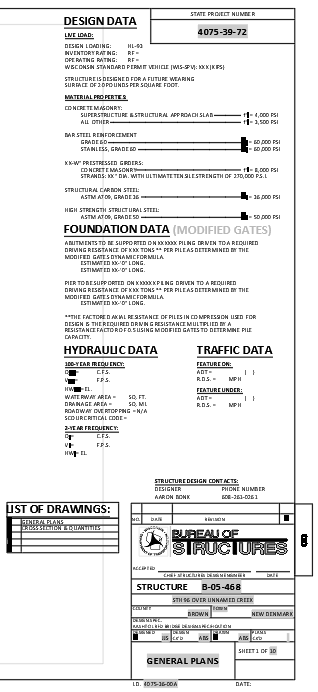
Finish structure plan
-
With the model space open, place any needed blocks in the Plan section of the General Plans palette.
Info: In general, all of the blocks on the General Plans palette should be placed in model space at a scale equal to the annotation scale. The exceptions are the Lane Arrows and Elevation Scale blocks (which should always be placed at scale 1) and the Cross Slope block (which should be scaled down by 12).
- Use the Quick annotations to annotate the structure plan. Keep the Structures drafting etiquette in mind while drafting.
- Follow the steps on the Structures external references page to ghost any references that should be shown in the final plans, and unload any other references.
-
Use the Sheet Tools - Align Viewport tool to rotate the existing viewport in the sheet layout.
Requirement: The model space coordinate system needs to be set to WCS before using this tool. For more information see the Structures coordinate systems page.
-
Resize the existing viewport and set it to use the same annotation scale as used in the model space. Follow the instructions on the Structures sheet layouts and viewports for more information.
At this point, the general plan sheet layout should look like this:
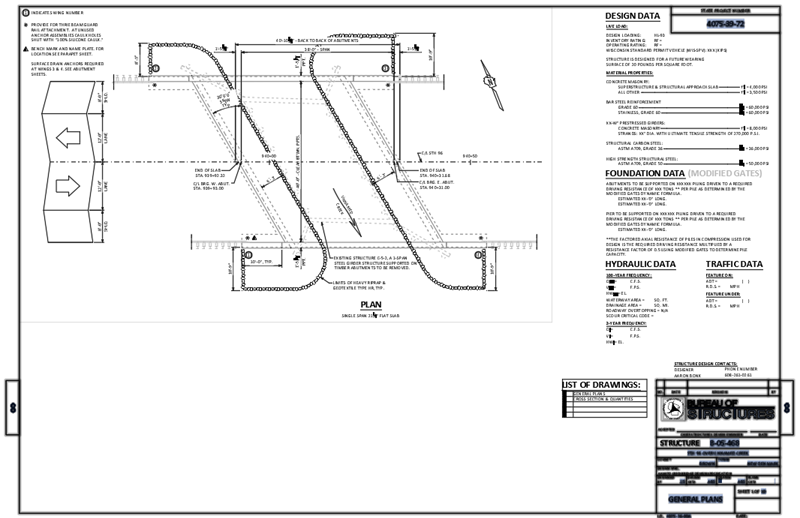
Structure elevation
- In model space, draw the elevation view below the plan. Use the blocks in the Elevation section of the General Plans palette. Pay attention to the Structures drafting etiquette , and be sure to use appropriate Structures template layers.
- Copy the plan viewport or extend it to fit both the plan and elevation. Follow the instructions on the Structures sheet layouts and viewports .
At this point, the general plan sheet layout should look like this:
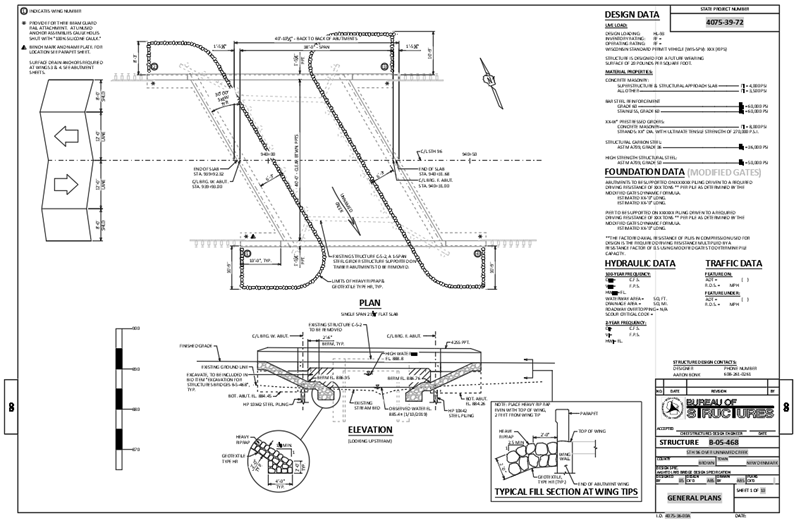
List of drawings
Once all sheets are complete, make sure to update the total pages property in the sheet set and REA to update the sheet border. Follow the directions on the Structures sheet sets of the sheet set page to create a sheet list using the sheet set manager.
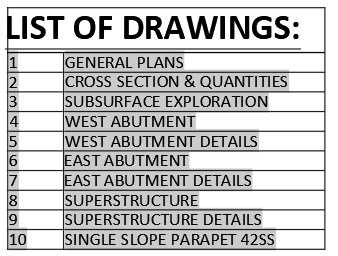
 Cross section and quantities sheet
Cross section and quantities sheet
Info: New bridges are typically the only structure type to have a separate Cross Section and Quantities sheet. Rehabs and other structure types tend to combine the general plans and quantities on one page.
File setup
- Start a new drawing file with the Details/Architectural Template. For more information see Structures drawing templates .
- Save the new file to the structure CAD folder. The drawing should be named YEAR-02-STRUCTID_QUAN.dwg or for this example 2021-02-B05468_QUAN.dwg.
Structure cross section
- Draw the cross section thru the bridge. Don't worry about any dimensions or annotations yet. Be sure to use appropriate Structures template layers .
- Determine the best annotation scale for the structure plan by inserting a Viewport Outline block (Structures tool palette > Misc. palette > Viewport section > Outline). Try using different scales for the block to see which fits the cross section best. The cross section should fit in the upper left corner of the sheet with room for the bid item table below and the general notes on the right. The scale needed for the block will be equal to your annotation scale for the plan.
- Set the active annotation scale equal to the viewport outline scale.
- Use the Quick annotations to annotate the structure cross section. Keep the Structures drafting etiquette in mind while drafting.
-
Draw a rectangle around the structure cross section on B_ANNO_NOPLOT. This rectangle will be used to resize the viewport.
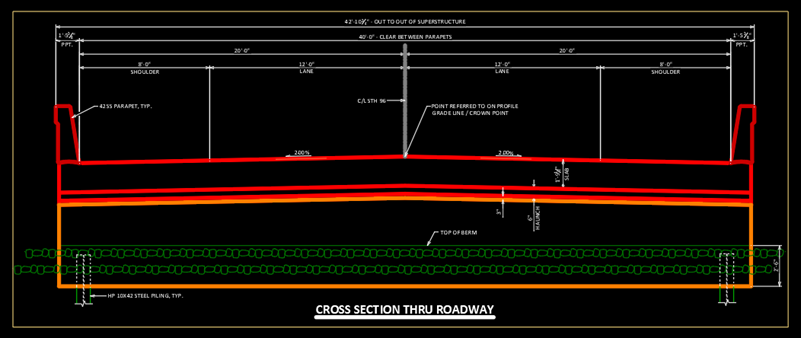
Sheet layout setup
- Create a Sheet 2 layout using the structures sheet templates. For more information see the Structures drawing templates page.
- SAVE the drawing so the new layout can be added to the sheet set.
-
Right-click the new sheet layout and Import Layout as Sheet... to add the sheet to your sheet set.
Requirement: You must have your sheet set open in the sheet set manager (SSM) first.
Info: For more information about how to add sheet layouts to a sheet set, see the Structures sheet sets page.
After completing the sheet properties in the sheet set manager, REA to update the sheet border.
-
Set the annotation scale for the viewport equal to the annotation scale used to draw the structure cross section. Pan and resize the viewport so it matches the rectangle drawn around the cross section. Move the viewport to the upper left corner of the sheet. For more information, see the Structures sheet layouts and viewports page.
Bid items and quantities table
With the sheet layout created in the previous section open:
- Open the Cross section and quantities blocks #quan palette.
- Place the Bid Item Table block in the bottom left corner of the sheet at scale 1.
- Use the dynamic block dropdown to choose the structure type. In the final menu, choose Table for this example (not OLE).
- EXPLODE the block.
- Edit the bid item table directly, or use the Paste table tool to paste data from an excel table. For this example, an excel table has been provided with the bid item data.
General notes and detail blocks
With the sheet layout open:
- Open the Cross section and quantities blocks #quan palette.
- Place the applicable blocks in the General Notes and Typical Details sections. All of these blocks should be placed at scale 1.0 in paper space.
- Make customizations to the blocks as needed.
 Subsurface exploration sheet
Subsurface exploration sheet
Info: The Bureau of Structures receives the subsurface exploration details as a MicroStation DGN file. Convert the drawing to Civil 3D first using the Convert DGN drawing tool.
The subsurface exploration sheet should be set up similarly to the general plan sheet. There is a special Structures drawing templates and sheet border block for the subsurface exploration sheet. The Miscellaneous blocks #misc contains blocks for the subsurface exploration grid and boring table. In the example files, the subsurface exploration drawing is named 2021-03-B05468_SOILS.dwg.
 Substructure sheets
Substructure sheets
Similar substructure sheets can all be combined in one drawing. It is useful to combine similar sheets in one drawing so similar or identical details can be easily referenced or copied when drawing. The example substructure drawing, 2021-04-B05468_ABUT.dwg contains 4 sheets:
- WEST ABUTMENT
- WEST ABUTMENT DETAILS
- EAST ABUTMENT
-
EAST ABUTMENT DETAILS
Each sheet in this drawing has two viewports with different annotation scales. In the model space, these viewports are generally defined with a polyline drawn in B_ANNO_NOPLOT and a noplot text note documenting the annotation scale for each detail. The viewport scales can also be confirmed by selecting each viewport in paperspace, as shown on the Structures sheet layouts and viewports page.
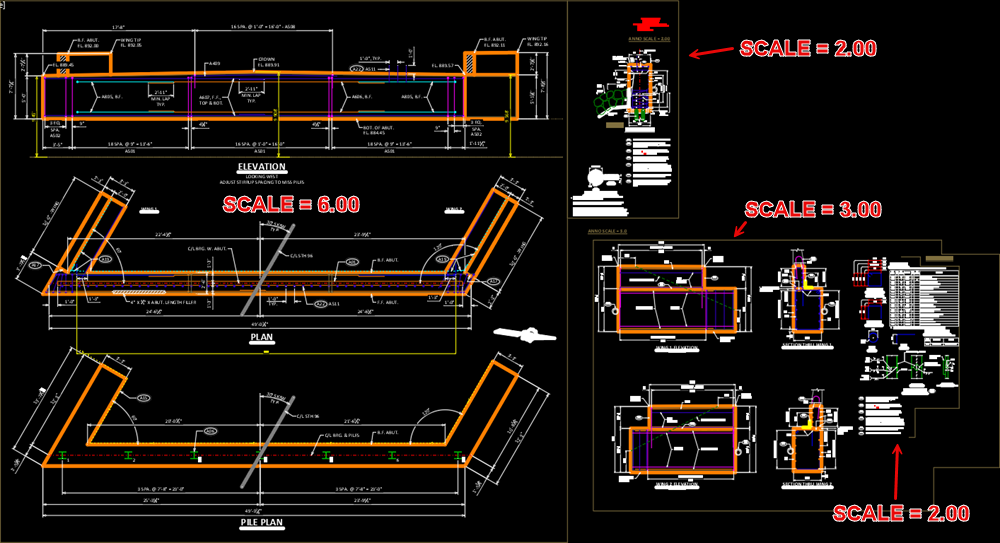
The substructure drawing also contains a reference to the LAYOUT.dwg drawing. Note that because the substructure drawing uses a Details/Architectural template, the layout file references in 12x too small. In this drawing the reference is kept at a scale of 1.0, but then two copies of the reference are made. Each copy is scaled and rotated to line up with the substructure sheet. References like this can be either used directly in the plan details, or as in this drawing, just used as a reference while drafting.
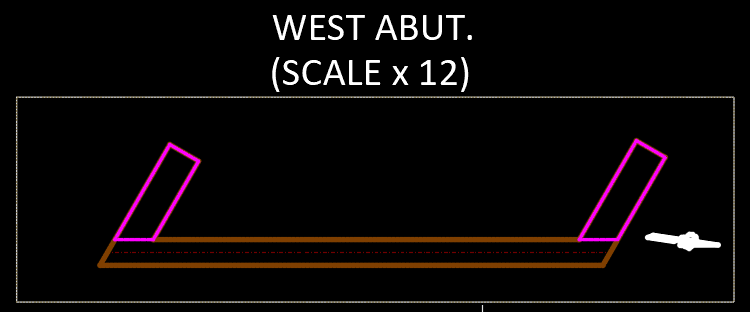
Rebar detailing
Blocks for rebar detailing are available in the Rebar blocks #rebar . Similar to the Bid Item Table block covered earlier, the bill of bars table contains dynamic options to choose the sheet type and whether to use an OLE table or built-in table for the bill of bars. It is recommended to use the TABLE options where possible, since importing data as an OLE object can cause file slowdown or corruption. EXPLODE the block after selecting the required table. The table can be edited directly in C3D, or the Paste table tool can be used to paste data from a spreadsheet. Bill of Bars.xlsx in the example files contains the bar data to paste into C3D.
 Superstructure sheets
Superstructure sheets
Superstructure plan and cross section
The 2021-08-B05468_SUPER.dwg drawing in the example files contains the superstructure cross plan and cross sections. This example sheet uses 4 different viewports, each at a different annotation scale. In addition, the LAYOUT.dwg reference drawing is referenced into the drawing. Since the superstructure drawing uses a Details/Architectural template, the layout file references in 12x too small. The reference is copied, scaled, and rotated to be used directly in the plan detail.
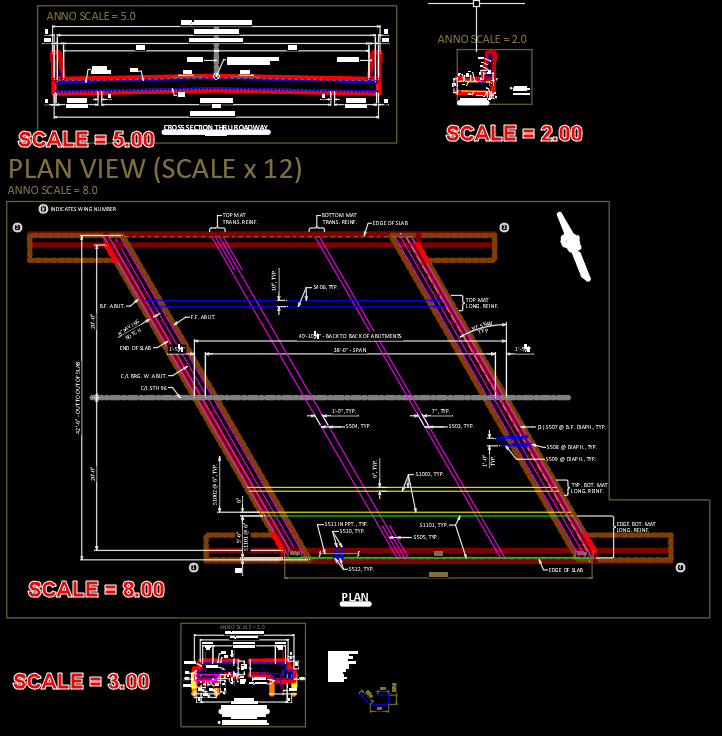
Superstructure details
The 2021-09-B05468_SUPERDET.dwg drawing in the example files contains superstructure details like the bill of bars and bar bend diagrams, slab camber details, and top of slab elevations. In this drawing, everything is drawn directly on the sheet layout because there are no scaled details. Unlike the substructure sheets, the superstructure sheets are split into two drawings because they don't have shared or similar details. However, the sheets could be combined into one drawing at the drafter's preference.
Follow the Rebar Detailing section above for more information about creating the bill of bars table. The top of slab elevations table is created in the same way as the bill of bars and bid items tables. A spreadsheet containing the top of slab elevations is provided with the example files named Top of Deck.xlsx
 Insert sheets
Insert sheets
For more information about insert sheets, see the Structures insert sheets page. The 2021-10-B05468_PPT.dwg is a Single Slope Parapet 42SS insert sheet modified to meet the needs of this structure.
 Drawing cleanup and closeout
Drawing cleanup and closeout
Be sure to clean your drawings and make them ready for project closeout by following the steps on the Structures drawing cleanup and closeout page.
 Plotting
Plotting
See the Structures plan plotting page for information about how to plot the plan set.